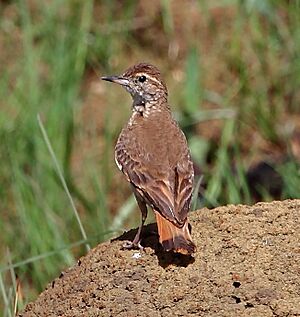Campo miner facts for kids
Quick facts for kids Campo miner |
|
|---|---|
 |
|
| Conservation status | |
| Scientific classification | |
| Genus: |
Geositta
|
| Species: |
poeciloptera
|
 |
|
| Synonyms | |
|
Geobates poecilopterus (Wied, 1830) |
|
The campo miner (Geositta poeciloptera) is a small bird that belongs to the ovenbird family. It's called a "miner" because it often digs for food. This bird is considered a Vulnerable species, meaning its population is at risk. You can find the campo miner mainly in Brazil and Bolivia. Sometimes, it might even be seen in Paraguay.
Contents
What Kind of Bird Is It?
The campo miner is part of a group of birds called "miners" (genus Geositta). It's the only species in its specific group, which means there aren't any different types of campo miners. Scientists used to think it was in a different group, but new studies show it belongs with the other miners.
What Does the Campo Miner Look Like?
The campo miner is a small bird, about 11 to 12 centimeters (4 to 5 inches) long. It weighs about 17 to 19 grams (0.6 to 0.7 ounces), which is like weighing a few quarters. Male and female campo miners look very similar.
It has a dull reddish-brown face with a light, creamy stripe above its eye. Its back, from its head to its tail, is a dull grayish-brown. The feathers on its lower back and tail have a reddish tint. Its tail is short and has reddish feathers with a dark brownish band near the end.
Its wings are dark brownish with lighter edges. When it flies, you can see a wide, reddish-brown band on its flight feathers. Its throat is whitish, and its upper chest is a dull, creamy color with small brown spots. The rest of its belly is whitish, and its sides are a pale reddish color.
The campo miner has brown eyes. Its short beak is dark, sometimes with a pale or pinkish-gray base. Its legs and feet can be pale brown, gray, or even a dull pink.
Where Does the Campo Miner Live?
The campo miner lives in south-central Brazil, in areas like Mato Grosso, Bahia, and Paraná. It also lives in northeastern Santa Cruz Department in Bolivia. There has been at least one sighting in Paraguay.
This bird prefers open grasslands and a type of landscape called cerrado. These areas have few or no trees. Campo miners especially like recently burned areas, which they often use for breeding. They live at elevations between 500 and 1250 meters (1,600 to 4,100 feet) above sea level.
How Does the Campo Miner Behave?
Moving Around
The campo miner does not migrate long distances. However, it does move locally to find suitable places to live.
What Does It Eat?
Campo miners usually look for food alone or in pairs. They hop on the ground to pick up their food. Their diet mainly consists of small creatures like insects and spiders. They are known to eat ants, beetles, praying mantises, and spiders.
How Does It Breed?
Scientists don't know everything about the campo miner's breeding season, but it includes at least September and October. The few nests that have been found were inside side tunnels of armadillo burrows. The birds lined these tunnels with dry grass and hair. One nest was found with three eggs.
What Does It Sound Like?
When the campo miner performs its display flight, it sings a "high, level, hurried, rolling 'turruturrut---'" song. This song can last for 15 to 20 seconds. Its call when flying is a simple "pit-pit".
Why Is the Campo Miner Vulnerable?
The IUCN (International Union for Conservation of Nature) first listed the campo miner as "Near Threatened." But since 2009, it has been listed as "Vulnerable." This means its population is decreasing quickly.
The main reason for this is that much of its natural cerrado habitat has been turned into farmland for crops, ranches for cattle, or plantations of trees that are not native to the area. Also, efforts to stop natural fires have sometimes reduced the breeding areas that these birds prefer. Even though it lives in some protected areas, the campo miner is generally considered uncommon or rare. In 2014, authorities in Brazil declared it an Endangered species.


